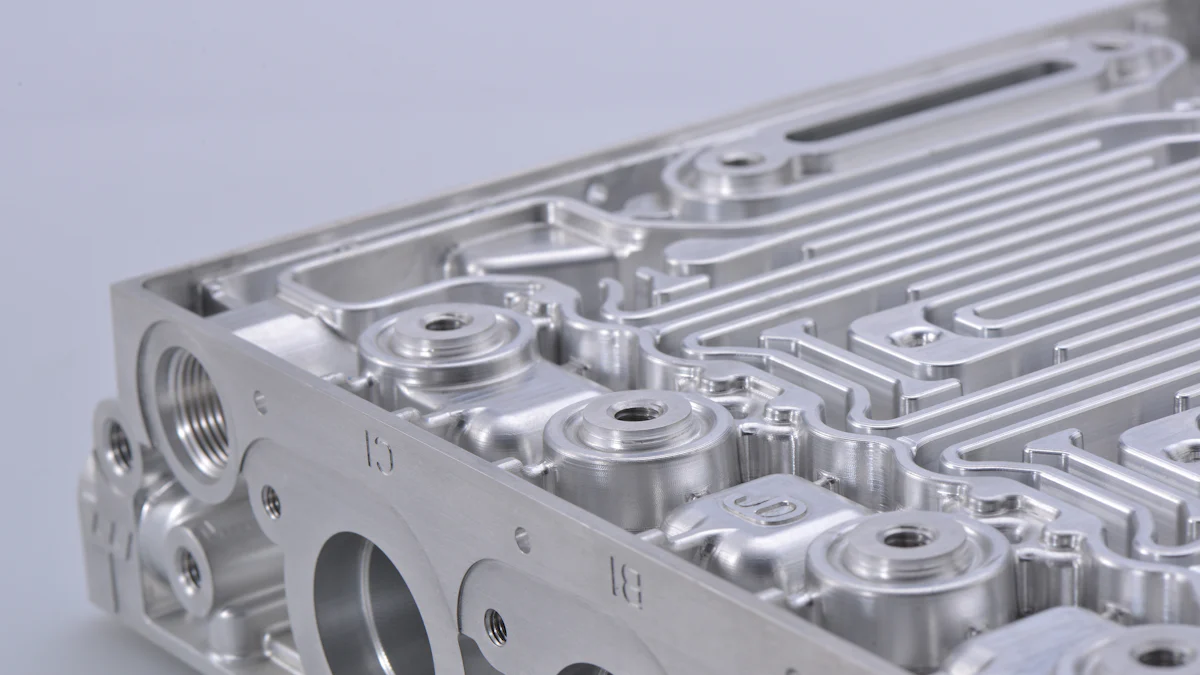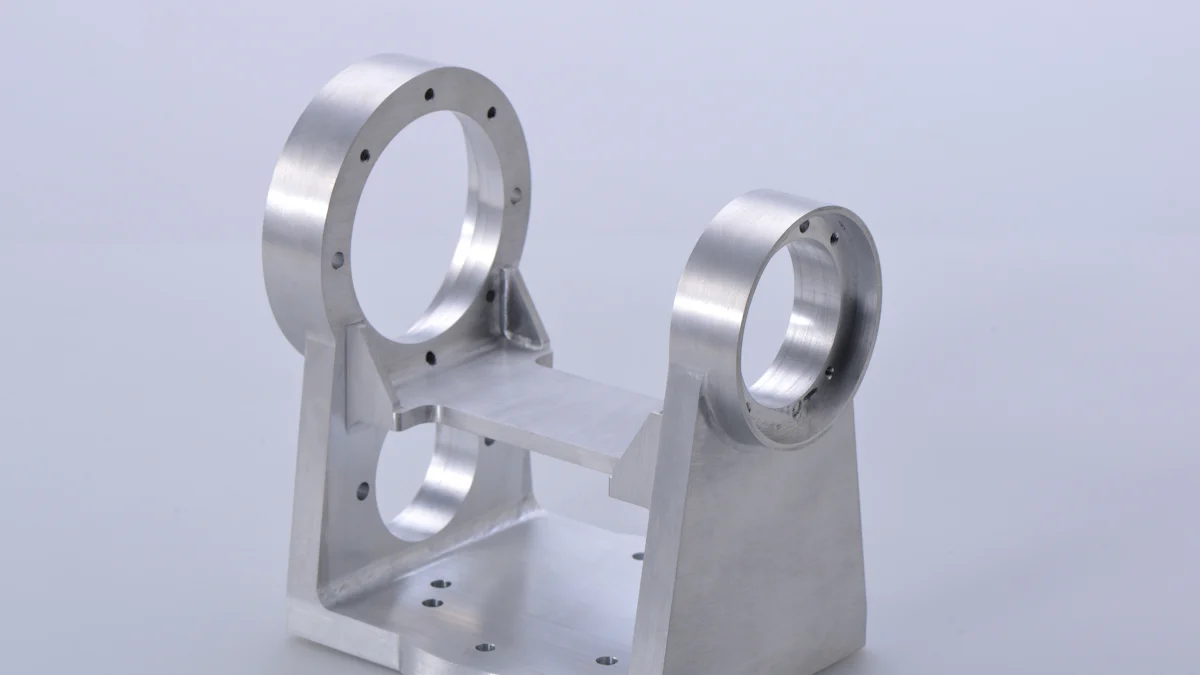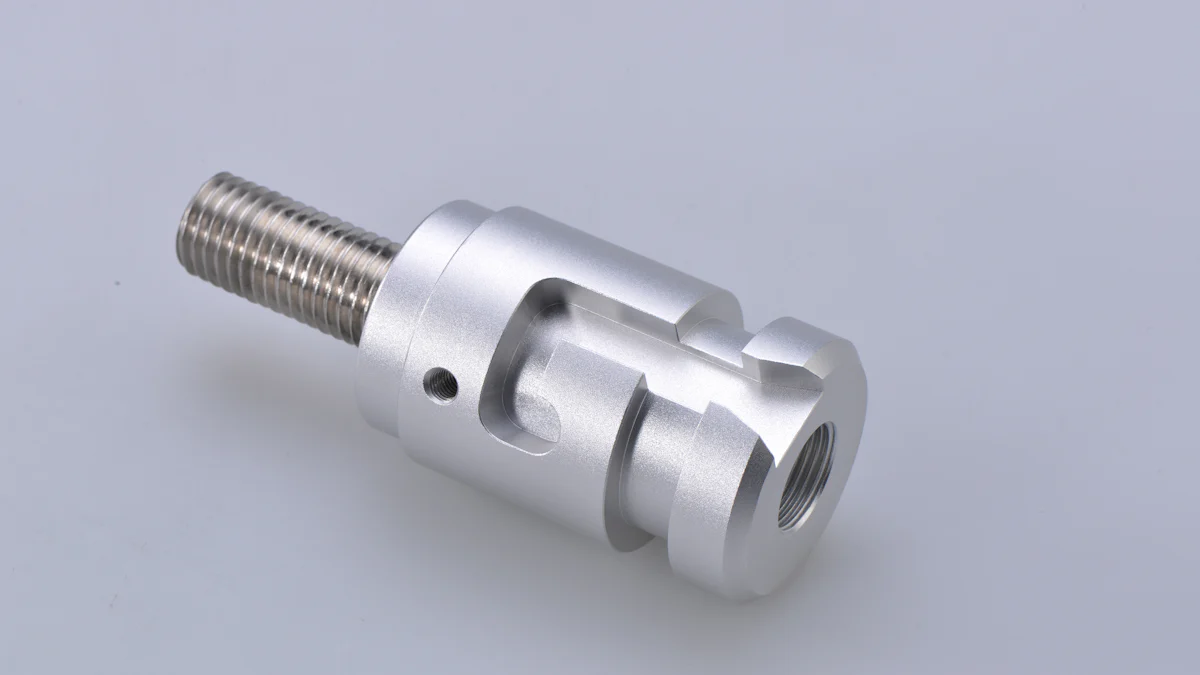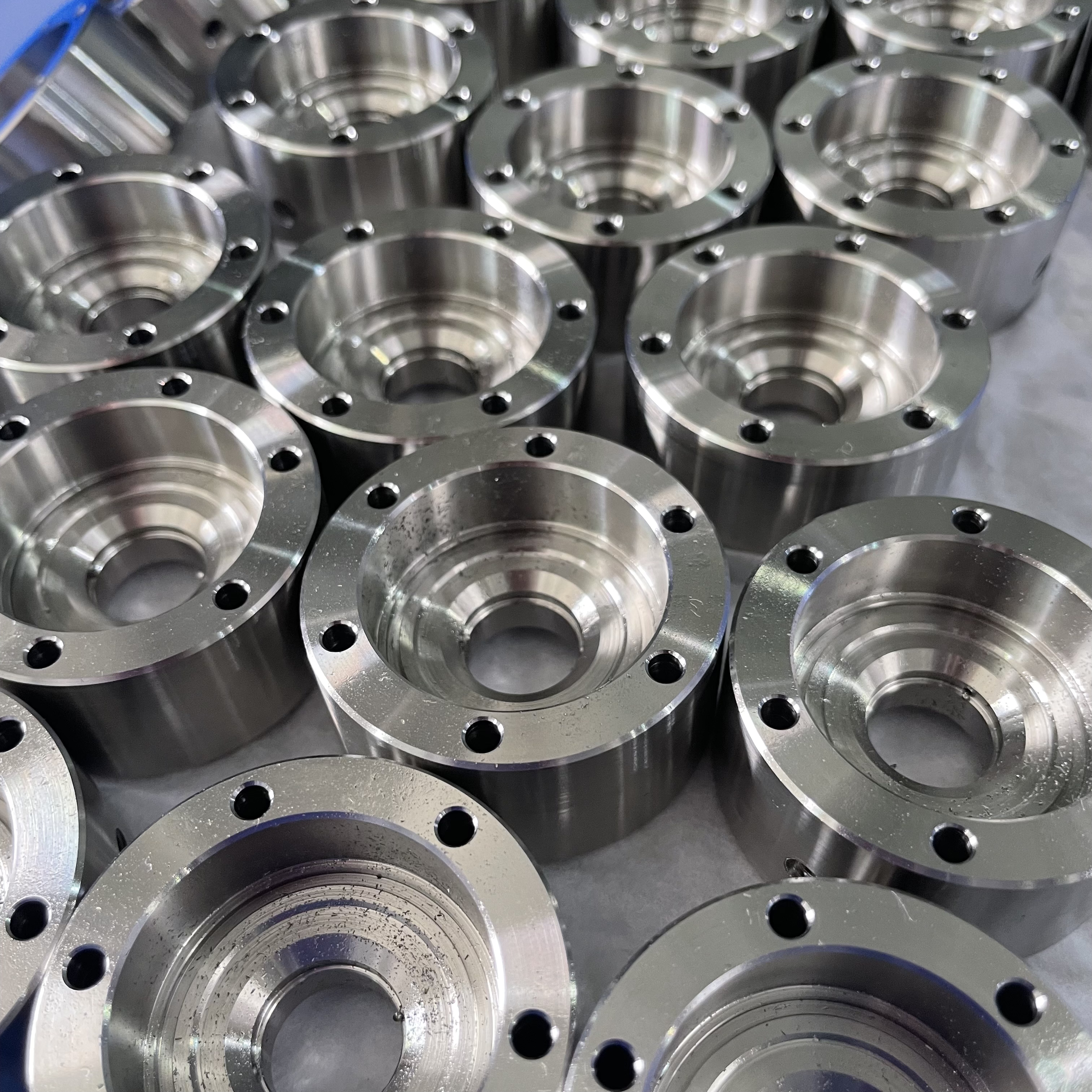Corrosion Resistance in CNC Machined Parts

Corrosion can significantly reduce the performance and lifespan of CNC machined parts. You must prioritize corrosion resistance to ensure durability in challenging environments. Factors like chemical exposure, moisture, and galvanic reactions often accelerate material degradation. Proper surface preparation, such as cleaning and degreasing, helps prevent corrosion by removing contaminants. Protective coatings, including anodizing and powder coating, create barriers against corrosive elements. By understanding these influences, you can make informed decisions to enhance the longevity of your CNC machining projects.
Key Takeaways
Focus on stopping rust in CNC parts to make them last longer.
Use materials like stainless steel or aluminum that don’t rust easily and are easy to shape.
Add coatings like anodizing or powder coating to block water and chemicals.
Design parts with good drainage and sealing to keep out harmful stuff.
Check and care for parts often to find rust early and keep them working well.
Material Selection for CNC Machined Parts
Choosing the right material is critical for ensuring the durability and performance of CNC machined parts. Each material offers unique properties that contribute to corrosion resistance and overall functionality.
Corrosion-Resistant Metals
Stainless Steel and Its Benefits
Stainless steel is a popular choice for CNC machining due to its excellent corrosion resistance. Austenitic stainless steels, such as grades 304 and 316, contain chromium and nickel, which form a protective oxide layer. This layer prevents rust and enhances durability. Ferritic stainless steels, with higher chromium content, offer even greater resistance but are less ductile. Martensitic stainless steels provide rigidity but are less resistant to corrosion compared to austenitic grades. For most environments, stainless steel 304/304L is a reliable option due to its machinability and mechanical strength.
Aluminum Alloys and Oxide Layers
Aluminum alloys are lightweight and naturally form a protective oxide layer when exposed to air. This layer shields the material from moisture and chemicals, making it ideal for high-humidity environments. Aluminum also offers excellent machinability, which reduces manufacturing costs.
Titanium Alloys for Strength and Corrosion Resistance
Titanium alloys combine exceptional strength with outstanding corrosion resistance. These alloys perform well in harsh environments, including those with chlorine exposure. Their high strength-to-weight ratio makes them a preferred choice in aerospace and marine applications.
Non-Metallic Options
Plastics and Composites for Chemical Resistance
Plastics and composites resist chemical corrosion effectively. Materials like PTFE and PEEK are lightweight and non-reactive, making them suitable for applications involving acids or solvents.
Ceramics for Extreme Wear Resistance
Ceramics excel in environments requiring extreme wear resistance. They withstand high temperatures and resist oxidation, making them ideal for precision parts in demanding conditions.
Key Considerations in Material Choice
Environmental Factors
Environmental conditions like humidity and temperature significantly influence material selection. For example, high-humidity environments require materials resistant to rust, while high-temperature settings demand materials that maintain structural integrity.
Environment Type | Material Requirements |
|---|---|
High-Humidity Environment | Materials should have good moisture resistance to prevent rust and mold. |
High-Temperature Environment | Materials must withstand deformation, melting, or oxidation while maintaining performance. |
Balancing Cost and Performance
Balancing cost and performance is essential when selecting materials. Budget-friendly options like aluminum work well for general applications, while premium materials like titanium are better for high-value projects. Material costs vary widely; for instance, aluminum costs around $1 per pound, while copper is over three times as expensive. Consider the performance-to-cost ratio to ensure the material meets your project’s needs without exceeding your budget.
Surface Treatments for Corrosion Resistance

Surface treatments play a vital role in enhancing the corrosion resistance of CNC machined parts. By applying the right treatment, you can protect components from environmental damage and extend their lifespan.
Common Surface Treatments
Anodizing for Enhanced Durability
Anodizing is an electrochemical process that creates a protective oxide layer on aluminum surfaces. This layer improves corrosion resistance and wear resistance, making it ideal for CNC machined parts exposed to harsh environments. Anodized finishes also allow for dyeing, giving you the option to customize the appearance of your components.
Passivation for Stainless Steel
Passivation enhances the natural corrosion resistance of stainless steel. This chemical treatment removes surface contaminants and promotes the formation of a chromium-rich oxide layer. The process ensures that your stainless steel parts remain durable and resistant to rust, even in challenging conditions.
Protective Coatings
Powder Coating for Impact and Corrosion Resistance
Powder coating involves applying a dry powder to the surface of a part, which is then cured in an oven. This process creates a durable, uniform surface coating that resists chipping, chemicals, and UV rays. Powder coating is particularly effective when combined with bead blasting, which ensures a smooth and even surface.
Electroplating for Enhanced Surface Protection
Electroplating deposits a thin layer of metal, such as nickel or chrome, onto the surface of a part. This plating method enhances corrosion resistance and provides a polished, aesthetically pleasing finish. Electroplated coatings are commonly used in applications requiring both functionality and visual appeal.
Advanced Coating Techniques
PVD and CVD Coatings
Physical Vapor Deposition (PVD) and Chemical Vapor Deposition (CVD) are advanced techniques that apply thin, hard coatings to CNC machined parts. These methods improve wear resistance and corrosion resistance, making them suitable for high-performance applications.
Nano-Coatings for Cutting-Edge Applications
Nano-coatings use nanotechnology to create ultra-thin protective layers. These coatings offer exceptional resistance to corrosion and wear while maintaining the precision of CNC machining. Nano-coatings are ideal for industries like aerospace and medical devices, where performance and durability are critical.
Tip: Choosing the right surface treatment depends on your material, application, and environmental conditions. For example, anodizing works best for aluminum, while passivation is tailored for stainless steel.
Design Considerations to Prevent Corrosion

Minimizing Corrosive Exposure
Sealing and Enclosures
Sealing and enclosures protect CNC machined parts from exposure to corrosive elements like moisture, chemicals, and debris. You can use gaskets, O-rings, or custom enclosures to create a barrier that prevents contaminants from reaching the surface. For outdoor applications, weatherproof seals ensure long-term corrosion resistance. Proper sealing also reduces maintenance needs by keeping parts clean and dry.
Drainage Design to Prevent Water Accumulation
Water accumulation accelerates corrosion, especially in humid or wet environments. Designing parts with proper drainage channels allows water to flow away, reducing the risk of rust formation. Sloped surfaces and strategically placed holes help prevent stagnant water from pooling. This simple design adjustment significantly enhances the durability of CNC machined parts.
Avoiding Galvanic Corrosion
Material Pairing and Insulation
When two dissimilar metals come into contact, galvanic corrosion can occur. You can avoid this by pairing metals with similar electrochemical properties. For example, using aluminum and stainless steel together requires careful consideration. Insulation techniques, such as adding washers, sleeves, or tapes, create a physical barrier between metals. Sealants and adhesives further enhance protection by preventing direct contact and reducing moisture infiltration.
Strategy | Description |
|---|---|
Material Compatibility | Choose metals with similar electrochemical properties to reduce corrosion risk. |
Insulation Techniques | Use washers, sleeves, or tapes to separate dissimilar metals and prevent contact. |
Sealants and Adhesives | Apply sealants to block moisture and enhance protection in mixed-metal assemblies. |
Optimizing Geometry for Wear Resistance
Reducing Crevices and Sharp Edges
Crevices and sharp edges trap moisture and debris, creating ideal conditions for corrosion. You can reduce these risks by incorporating rounded transitions, such as fillets, into your designs. Fillets distribute stress evenly, improving both wear resistance and structural integrity. Chamfers, which are angled transitions, also enhance machinability and reduce the likelihood of part deformation.
Ensuring Proper Ventilation
Proper ventilation prevents moisture buildup, which is critical for maintaining corrosion resistance. You can include ventilation holes or slots in your designs to allow air circulation. This design strategy is especially useful for enclosed parts or assemblies. By promoting airflow, you reduce the risk of condensation and extend the lifespan of your CNC machined parts.
Tip: Combining thoughtful design with corrosion-resistant materials and coatings ensures optimal performance and durability in your CNC machining projects.
Machining Processes and Quality Control
Precision CNC Machining
Avoiding Surface Defects
You can prevent surface defects in CNC machining by employing high-speed machining (HSM). This technique uses high spindle speeds and feed rates to efficiently remove material, resulting in smooth finishes for complex geometries. HSM also reduces tool wear, improving both productivity and accuracy.
To further minimize defects:
Optimize cutting speed, feed rate, and depth of cut.
Monitor tool wear and replace tools as needed.
Use advanced CNC programming to create precise toolpaths.
Regularly calibrate and maintain CNC machines.
Select materials with consistent properties.
Train operators to reduce human error.
Periodic machine calibration and addressing mechanical issues also help retain accuracy and prevent quality degradation. These practices ensure your precision parts meet high standards.
Maintaining Tight Tolerances
Maintaining tight tolerances is essential for producing reliable components. You achieve this by using advanced CNC machines capable of precise measurements. Regular maintenance and compensation techniques help mitigate machine tool errors. Tight tolerances not only improve part functionality but also enhance the overall durability of your machined components.
Post-Machining Treatments
Deburring and Polishing for Smooth Surfaces
Deburring and polishing remove sharp edges and surface imperfections. These treatments enhance corrosion resistance, ensuring longer-lasting parts. They also eliminate contaminants that could affect other components. By improving surface smoothness, you reduce maintenance needs and ensure operational efficiency.
Stress Relieving for Durability
Stress relieving involves heating parts to reduce internal stresses caused by machining. This process improves the structural integrity of your components, making them more resistant to deformation and fatigue. Stress-relieved parts perform better in demanding environments, extending their service life.
Quality Control Practices
Corrosion Testing and Inspection
Testing ensures your parts can withstand harsh conditions. The Salt Spray Test, for example, evaluates corrosion resistance by exposing parts to a controlled saline environment. Regular inspections help identify potential issues early, ensuring your components remain reliable.
Adherence to Industry Standards
Following industry standards guarantees high-quality results. Use corrosion-resistant materials like stainless steel or aluminum. Apply protective coatings, such as plating treatments, to shield parts from environmental factors. These practices ensure your CNC machining projects meet performance and durability requirements.
Tip: Combining precision machining, post-treatment processes, and rigorous quality control ensures your parts remain durable and corrosion-resistant.
Maintenance and Storage Practices
Proper Storage Conditions
Controlling Humidity and Temperature
You can prevent corrosion by controlling humidity and temperature in storage areas. A dry, clean, and well-ventilated environment minimizes moisture buildup, which reduces the risk of rust. Use desiccant bags to absorb excess moisture and maintain a dry atmosphere. Ensure proper air circulation to dissipate humidity effectively. Regularly inspect stored parts for signs of rust or corrosion. These inspections help you detect and address potential issues early, ensuring your CNC machined parts remain in optimal condition.
Using Protective Packaging
Protective packaging acts as a barrier against environmental factors that cause corrosion. Materials like desiccant bags and moisture-resistant wraps keep out water and contaminants. For added protection, seal parts in airtight packaging to block exposure to air and humidity. This method is especially useful for long-term storage or transportation. By combining proper packaging with controlled storage conditions, you can significantly extend the lifespan of your CNC machined components.
Best Practices for Transportation
Avoiding Moisture Exposure
During transportation, moisture exposure poses a significant risk to corrosion resistance. You can mitigate this by using waterproof covers or sealed containers. Avoid transporting parts in high-humidity conditions whenever possible. If exposure to moisture is unavoidable, ensure parts are thoroughly dried before packaging. These precautions help maintain the integrity of your components during transit.
Using Corrosion Inhibitors
Corrosion inhibitors provide an additional layer of protection during transportation. Apply these inhibitors to metal surfaces to prevent oxidation and rust. For example, vapor-phase corrosion inhibitors (VCIs) release protective vapors that form a barrier on the part's surface. This method is highly effective for safeguarding CNC machined parts in transit, especially over long distances or in challenging environments.
Maintenance for Long-Term Corrosion Resistance
Regular Cleaning and Lubrication
Routine cleaning removes residues like dirt, oil, and cutting fluids that can lead to corrosion. Use suitable detergents to clean parts thoroughly after machining. Lubrication also plays a vital role in protecting metal surfaces. Apply high-quality lubricants to reduce friction and create a protective layer against moisture. These practices ensure your parts remain functional and corrosion-free over time.
Periodic Inspections for Early Detection
Frequent inspections allow you to identify early signs of corrosion before they escalate. Look for discoloration, pitting, or surface irregularities during these checks. Non-destructive testing methods, such as ultrasonic or visual inspections, help you assess the condition of your parts without causing damage. By addressing issues promptly, you can prevent further deterioration and maintain the performance of your CNC machined components.
Tip: Combining proper storage, transportation, and maintenance practices ensures your CNC machined parts stay corrosion-resistant and durable for years to come.
Enhancing corrosion resistance in CNC machined parts requires a combination of smart strategies. You can start by selecting materials with similar electrochemical properties to prevent galvanic corrosion. Applying protective coatings, like zinc flake or anodizing, creates robust barriers against environmental damage. Design features, such as proper drainage and ventilation, further reduce corrosion risks. These measures not only extend the lifespan of your parts but also lower maintenance costs over time. By implementing these techniques, you ensure your CNC machined components remain durable, functional, and cost-effective. Take action today to protect your investments and improve performance!
FAQ
What is the best material for corrosion resistance in CNC machined parts?
Stainless steel and titanium alloys offer excellent corrosion resistance. Stainless steel resists rust due to its chromium content, while titanium alloys perform well in harsh environments. For non-metallic options, consider plastics like PTFE for chemical resistance.
How does anodizing improve corrosion resistance?
Anodizing creates a protective oxide layer on aluminum surfaces. This layer shields the material from moisture and chemicals. It also enhances wear resistance and allows for color customization, making it ideal for parts exposed to harsh conditions.
Can I prevent galvanic corrosion in mixed-metal assemblies?
Yes, you can prevent galvanic corrosion by pairing metals with similar electrochemical properties. Use insulation techniques like washers or tapes to separate dissimilar metals. Applying sealants also blocks moisture, reducing the risk of corrosion.
How often should I inspect CNC machined parts for corrosion?
Inspect parts every three to six months, depending on environmental conditions. Look for discoloration, pitting, or surface irregularities. Regular inspections help you detect early signs of corrosion and address them before they worsen.
Are nano-coatings worth the investment for corrosion resistance?
Nano-coatings provide exceptional protection against corrosion and wear. They are ideal for high-performance applications like aerospace or medical devices. While they may cost more, their durability and precision make them a worthwhile investment for critical components.
See Also
Grasping Material Needs for CNC Precision Machining Success
Proven Strategies for Flawless CNC Machining of Aluminum
Achieving Excellence in CNC Machining for Precision Components
Expert Insights on Surface Treatments in CNC Precision Machining
Exploring Anodizing Techniques for CNC Machined Aluminum Heat Sinks
About US
Follow Us
Your prototype holds unparalleled significance, and we deeply value its uniqueness. Collaborating with you during the preparation phase for running your prototype or parts is a commitment we gladly embrace. Whether it's a single part or a complex assembly, we are dedicated to selecting the optimal tools and pathways to bring your envisioned product to life.
At Precision Fab CNC Machining, we specialize in producing parts for prototypes, short runs, and high-volume production. Our prototyping machine capabilities extend across metal, plastic, and wood machining, with welding fabrication services available to complement and finalize your prototype if required.
Address
Address: Room320 10F, Building A,Nanshan international building, Dayawan District, Huizhou, Guangdong, 516001 China
Contacts
billy@timaycnc.com

